Steam Brigade: Physics in a Side-Scrolling RTS
Steam Brigade is Pedestrian Entertainment’s debut game, and it’s certainly a great first product for a studio. They concisely describe Steam Brigade as a side-scrolling, real-time strategy game set in an alternate history where airships and steam-powered tanks rule the battlefield. Principally, the game is one of strategy–choosing which units to spawn for which situations. The only way to interact with units once they are spawned, though, is to physically interact with them.
Real-Time Strategy Redefined
Typically a “real-time strategy game” brings to mind doling out orders to units: move here, attack that, defend this. Steam Brigade does away with unit management in the abstract. Once you spawn a tank or foot soldier they’re completely autonomous.
Your units aren’t totally helpless, though. You, the player, pilot an airship. It’s a fragile thing–you can’t shoot, or bomb, or really do much damage at all. You can, however, pick up units with a rather large magnet hanging off the ship. This is how you interact with your troops after they’ve spawned. You can whisk a unit to the front lines, dangle a still-firing tank from your underbelly, and even pick up enemy units to drop them to splattering results.
Steam Brigade Strategies
Steam Brigade’s strategy reminds me of Gearheads, an old PC game. Units are set up in a roshambo arrangement: soldiers kill engineers, tanks kill soldiers, turrets kill tanks (an engineer is required to operate a turret), and so on. Successfully conquering an enemy position requires planning and some personal intervention with the airship. You need to send over the right combination of troops, but also ensure their survival.
Resources
Unlike most real-time strategy games, Steam Brigade does away with finite resources. It takes money to purchase units, but unlimited money flows in for free at a steady rate. You can even purchase a new airship for yourself if you manage to get shot down. The game can be hard, though, and certainly requires concentration. If you carelessly spawn units as your money trickles it’s very easy to become deadlocked in your advances. It’s usually better to think a bit, wait for your money pile to max out, and go for one big push.
AI and Frustration
The AI in Steam Brigade is pretty crafty. This is both good and bad. It’s bad because it quickly becomes frustrating to have your efforts constantly thwarted by the opposing airship. It’s good in a way, though, because the AI demonstrates a lot of the advanced physics techniques. Of course, it demonstrates these techniques by crushing you ever so gently.
Where’s the Physics?
Now, Steam Brigade doesn’t perfectly fit into my rough definition of a physics game. I like to call something a physics game when the primary means by which you interact with the game is through manipulation of a complex physics system. Steam Brigade’s physics, although they are driven by Newton Game Dynamics, aren’t exactly complex. And the primary gameplay interaction is actually deciding which units to spawn (although physics interaction is definitely where most of your actual time).
So why am I talking about it? Well, for one, the game is neat. I think it deserves some attention. But more importantly, I’d love to see a concept like this with more emphasis on physics. I think there’s huge potential for an updated Gearheads concept where opposing forts spit out physics contraptions at each other to do battle. Steam Brigade hints at this with physics-based tricks and techniques, but it would be great to have something conceptualized from the ground up as a physics-based game with a similar premise.
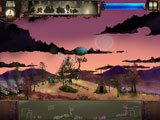
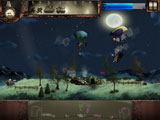
(Steam Brigade Game Screenshots)
Try it Out!
Steam Brigade’s pacing is a little slow, but it’s a unique game with solid production. If you’re looking for some physics fun in a 2D environment, and aren’t afraid of a little thinking, definitely give it a try today.
Download the game demo over at Pedestrian Entertainment’s Steam Brigade page (21.5 MB). The full version is $19.95. Well worth it!
Related Posts:
- Hammerfight (Hammerfall) Now Available on Steam
- Garry’s Mod Launches on Steam
- Rag Doll Kung Fu Headed to Retail
- List of Physics Games
- Trials 2SE Visual Upgrade, Same Great Physics
Mu-cade: The Physics Centipede Invasion
Mu-cade is a new shoot-em-up by the master of shmups, Kenta Cho of ABA Games. He pitches his game as a “smashup waggly shmup”, which is, by itself, reason enough to check it out. With Mu-cade, Kenta has introduced physics into his formula of hardcore shooting games. The result is a great physics game (even if it will kick your ass in five minutes or less).
A Note on Controls
Before I continue the review, I should point out that Mu-cade begs to be played with a dual-analog controller. It is possible to play with the keyboard, but you don’t really want to. The controls match those of games like Geometry Wars. One thumb stick controls your movement and one controls your direction of fire. If you play on the keyboard you simply lose fidelity and the ability to aim at precise angles. Get a PS2->USB converter, an Xbox 360 USB controller, or something. You’ll be glad you did.
Demented Sumo Gameplay
Mu-cade’s how to play section in the documentation reads in its entirety as follows: Keep your ship from falling down and push enemies out of the way. It’s an elegant premise for a game. You control a snake-like ship on a rectangular playfield. Other centipedes regularly spawn and shoot at you. You don’t have a health bar, and shots don’t do damage. Rather, shots push things around. You die if you fall off, and you kill enemies–and add their segments to your own centipede–by pushing them off.
Player Tactics
The only other action available to the player, in addition to shooting, is the ability to forfeit your tail. In exchange you are given a few seconds of mega-powerful shot. The longer your tail was, the longer this duration. When things get a little too hectic it can be advantageous to drop your tail to hurriedly dispose of your aggressors. Killing enemies grows your tail length again.
Also, you only die if the “head” of your ship falls off the side. When your tail gets long enough it will regularly dangle over the edge. This is harmless and sometimes actually useful–if your tail is hanging over the left side of the stage you can basically absorb any rightward shots without much recoil; your over-the-edge tail will basically act as an anchor. Other times, though, too much of your tail will fall over the edge and start to pull the head of your ship in after it. If you don’t realize this and jettison your tail quickly it will be game over before you know it.
Tall Tails!
Enemy centipedes quickly grow in strength. The game plays out like an old school arcade game. There are no levels; no breaks. Enemies increase in number and strength until you finally succumb to death’s sweet embrace. Things start to get crazy at the three- or four-minute mark. Enemies begin shooting a lot of shots in various patterns. It rapidly becomes a struggle to stay on the game board.
When things heat up, having a long tail practically becomes a requirement. A longer tail means more mass, which means you’re able to absorb more shots without flying all over the place. You can also wrap yourself around blocks and other centipedes in order to make it more difficult for attackers to bounce you around. When you do disconnect your tail out of necessity you really need to build it back up again as fast as possible. I’ve noticed that finding myself tailless is a good recipe for an early demise.
Technical Info
ABA Games is one of the few developers I’m aware of that uses the fledgling D Programming Language. Kenta has developed his own markup language to describe bullet movements, too, which enables him to easily describe various shot patterns and the like. The physics in Mu-cade are powered by ODE.
It’s Free!
Like all of Kenta’s work, Mu-cade is freeware. Download the game here (6.0 MB) or head over to ABA Games’ webpage to check out the rest of his work.
Mu-cade is a slick physics game and an example of how physics can be used to embellish well-trod genres. It’s a neat game and a good challenge. I have yet to pass the 5-minute mark. How far can you get?
Related Posts:
I Hate Clowns: Let Pie Gones Be Pie Gones
I Hate Clowns is a fun little game we developed in the Fall of 2003. It was the run-up to the Independent Games Festival deadline. Along with Beesly’s Buzzwords, we decided to submit whatever projects we had playable at the time. I Hate Clowns was created in the spare time of a very busy three days. The game is a little rough, as a result–the artistic production borderlines on placeholder. The fun is all there, though, so we decided to post it online for the world to enjoy.
Die Clowns, Die
The premise of I Hate Clowns is simple: You throw metal pies at clowns who are being inexplicably launched into the air like skeet shoot targets. You have a limited number of metal pies with which to brutalize these poor entertainers. Take it, clowns!
I Hate Clowns is a physics game in a very pure sense. Except for the scoring, the rest of the game mechanics rest on the physics engine: the ragdoll clowns, the metal pies, the physical dimensions of the playfield, etc. If we ever revisit the project it would be easy to extend the gameplay by designing more complicated playfields with various physics contraptions.
Scoring
Hitting an airborne clown, before he touches the ground, is worth 10 points. Each subsequent pie that smashes that clown before he meets the earth is worth an air combo of 2 points. All hits after that are ground hits and worth 1 point. It is possible for one pie to bounce between multiple targets and rack up multiple points.
Level Progression
Despite the simplistic scoring mechanic, there is some flexibility to changing the player experience. In the early levels most players learn to fire as many pies as possible as fast as possible. This usually results in the wailing akin to the moans of a thousand clowns. Later levels, though, play with the variables. Some levels severely limit pie count and require enough accuracy to pull off air combos at will. One level, “The Saddest Clown”, gives you 50 pies and a high point goal, but with only one clown (who truly becomes the saddest clown of all). There are 47 levels in total.
The Player Experience
Our goal with the game was to avoid complicated game mechanics and required learning curves. Instead, we just wanted the player to have fun and laugh a little. The sounds inch up to insanity, each level name is a terribly horrible pun, and we play a little with time scaling by slowing some levels down and speeding up others. The end result is the game is fun to just pick up and play for a few minutes. No explanation needed.
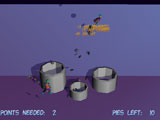
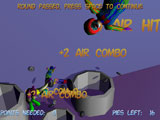
(I Hate Clowns Game Screenshots)
Play Free, Online!
The game is available to play right in your web browser with the Virtools Web Player. If you already have the player installed, the game is ~800k. Otherwise you’re looking at a few MB install beforehand. Check out the landing page for the game right here.
Mile Pie Club
I Hate Clowns was a fun project that took well under 10 hours to crank out. It certainly won’t make us any money; I’d be surprised if anyone would be willing to pay for something this sparse. Still, it’s a hoot to play and a great way to kill time when you should be working (especially if you should be working on games). It’s also a great way to kill clowns. Enjoy!
Related Posts:
- Walaber Experiments with Ragdolls and Aerial Skiing
- Physics-Based Beatdowns, Ragdoll Masters
- I Know Rag Fu: Ragdoll Matrix Reloaded
- Rubber Ninjas Gameplay Teaser
- Nimble Ninjas Face Ferocious Foes



 (Rate this game! 72 votes, average: 3.51 out of 5)
(Rate this game! 72 votes, average: 3.51 out of 5)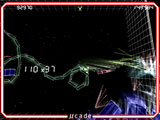
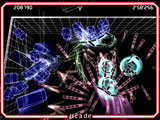
 My name is Matthew Wegner, and this site is dedicated to physics games.
My name is Matthew Wegner, and this site is dedicated to physics games.